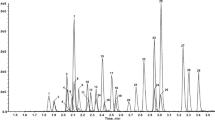Abstract
Hair samples collected from drug addicts (n=25) were analysed for opiates and cocaine by GC/MS. A decrease in drug concentration was observed even after a single bleaching or permanent wave application. The stability of the drug molecules in hair seemed to be different and cocaine was less affected than morphine or 6-acetylmorphine. When drug concentrations were low, the drug content often declined below the detection limit after cosmetic treatment. In hair samples which showed a drug content above 2 ng/ mg hair the qualitative detection of drugs was regularly successful. However, a distinct rule could not be established mainly due to influences of the individual hair matrix.
Zusammenfassung
Authentische Haarproben von Drogenkonsumenten wurden auf Opiate und ihren Kokaingehalt mittels GC/MS untersucht. Eine Abnahme der Suchtstoffkonzentrationen wurde sowohl nach in vitro Blondierung als auch nach Dauerwellbehandlung beobachtet. Die Untersuchungen zeigten, daß Kokain und Benzoylecgonin weniger beeinflußt worden waren als die Opiate, insbesondere als die Haarkonzentrationen von Morphin- und 6-Monoacetylmorphin (MAM). Neben einer Substanzabhängigkeit der Stabilität von Drogenmolekülen im Haar wurde ein Einfluß der individuellen Haarmatrix festgestellt. Eine klare Regel ließ sich aus den Ergebnissen nicht ableiten. Wichtig ist die Beobachtung, daß bei geringen Suchtstoffbelastungen der Haare eine einmalige kosmetische Anwendung bereits dazu führte, daß der Gehalt unterhalb die Nachweisgrenze sank, während bei Suchtstoffgehalten über 2 ng/mg Haar der qualitative Drogennachweis noch regelmäßig gelang.
Similar content being viewed by others
Literatur
Berg S (1977) Der Identifizierungswert des menschlichen Haares. Arch Kriminol 159:65–73
Cirimele V, Kintz P, Mangin P (1995) Drug concentration in human hair after bleaching. J Anal Toxicol 19:331
Franke J (1976) Zur bedeutung der Haar- und Barttracht in der Personenwahrnehmung. Psychol und Praxis 20:97–106
Kaplin IJ, Schwan A, Zahn H (1982) Effects of cosmetic treatments on the ultrastructure of hair. Cosm Toiletr 97:22–26
Moeller MR, Fey P, Wennig R (1993) Simultaneous determination of drugs of abuse (opiates, cocaine, amphetamine) in human hair by GC/MS and its application to a methadone treatment program. Forensic Sci Int 63:185–206
Nakahara Y, Simamine M, Takahashi K (1992) Hair analysis for drugs of abuse. III. Movement and stability of methoxyphenamine (as a model compound of methamphetamine) along hair shaft with hair growth. J Anal Toxicol 16:253–257
Orfanos CE, Ihmcke E (1990) Common hair cosmetic procedures and their physicochemical properties. In: Orfanos CE, Happle R (eds) Hair and hair diseases. Springer, Berlin Heidelberg New York, pp 888–925
Pötsch L, Skopp G (1996) Stability of opiates in hair fibers after exposure to cosmetic treatment. Forensic Sci Int 81:95–102
Pötsch L, Skopp G, Becker J (1995) Ultrastructural alterations and environmental exposure influence the opiate concentrations in hair of drug addicts. Int J Legal Med 107:301–305
Pötsch L, Skopp G, Möller MR (1996) Zum Suchtmittelnachweis in Haaren. II. Eine biochemische Erklärung für den endogenen Einbau von Pharmaka und illegalen Drogen ins Haar während der Anagenphase. Rechtsmedizin 7:1–5
Pötsch L, Skopp G, Zörntlein S, Becker J (1996) Zum Suchtmittelnachweis in Haaren. IV. Einfluß der Pigmentierung auf den Ofloxacingehalt in Haaren bei Meerschweinchen. Rechtsmedizin (zur Publikation eingereicht)
Robbins CR (1992) Chemical and physical behavior of human hair. Springer, Berlin Heidelberg New York
Shimada K, Baweja R, Sokoloski T, Patil PN (1976) Binding characteristics of drugs to synthetic levodopa melanin. J Pharm Sci 65:1057–1060
Skopp G, Pötsch L, Möller MR (1996) On cosmetically treated hair — aspects and pitfalls of interpretation. J Forensic Int (in press)
Zviak C (1986) The science of hair care. Marcel Dekker, New York Basel
Author information
Authors and Affiliations
Rights and permissions
About this article
Cite this article
Pötsch, L., Skopp, G. & Moeller, M.R. Zum Suchtmittelnachweis in Haaren. Rechtsmedizin 7, 113–116 (1997). https://doi.org/10.1007/BF03042385
Received:
Accepted:
Issue Date:
DOI: https://doi.org/10.1007/BF03042385




